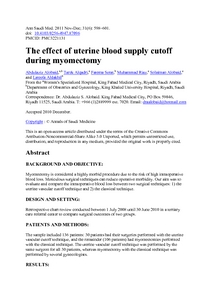Alobaid, A; Alqadri, T; Serat, F; Riaz, M; Alobaid, S; Aldakhil, L
(2011)
The effect of uterine blood supply cutoff during myomectomy.
Annals of Saudi Medicine, 31 (6).
pp. 598-601.
ISSN 0975-4466
https://doi.org/10.4103/0256-4947.87096
SGUL Authors: Riaz, Muhammad
![[img]](https://openaccess.sgul.ac.uk/105032/1.hassmallThumbnailVersion/Effect%20of%20uterine%20blood%20supply%20cutoff%20during%20myomectomy.pdf)  Preview |
|
["document_typename_cannot open `/data/SGUL/sgul/eprints3/archives/sgul/documents/disk0/00/10/50/32/01/Effect' (No such file or directory)
cannot open `of' (No such file or directory)
cannot open `uterine' (No such file or directory)
cannot open `blood' (No such file or dire" not defined]
Published Version
Available under License Creative Commons Attribution Non-commercial Share Alike.
Download (437kB)
| Preview
|
Abstract
BACKGROUND AND OBJECTIVE: Myomectomy is considered a highly morbid procedure due to the risk of high intraoperative blood loss. Meticulous surgical techniques can reduce operative morbidity. Our aim was to evaluate and compare the intraoperative blood loss between two surgical techniques: 1) the uterine vascular cutoff technique and 2) the classical technique.
DESIGN AND SETTING: Retrospective chart review conducted between 1 July 2008 until 30 June 2010 in a tertiary care referral center to compare surgical outcomes of two groups.
PATIENTS AND METHODS: The sample included 136 patients: 30 patients had their surgeries performed with the uterine vascular cutoff technique, and the remainder (106 patients) had myomectomies performed with the classical technique. The uterine vascular cutoff technique was performed by the same surgeon for all 30 patients, whereas myomectomy with the classical technique was performed by several gynecologists.
RESULTS: There was no significant difference between the two groups in parity and operation time; however, patients in the first group had a statistically significant higher mean age (39.1 [7.6] vs 35.8 [6.9] years; P=.025) and, on average, bigger fibroid size by gestational week (20.1 [7.3] vs 17 [5.2] weeks; P=.0094), with standard deviation shown in parentheses. There was a statistically significant lesser drop in hemoglobin concentration among patients in the first group (1.23 [1.2] vs 2.25 [1.4] g/dL; P=.0003), and the postoperative hemoglobin was significantly higher in the first group (10.5 [1.6] vs 9.7 [1.7] g/dL; P=.036). The hospital stay was shorter for patients in the first group (5.8 [1.7] vs 7.1 [2.9] days; P=.031).
CONCLUSION: The vascular cutoff technique leads to less intraoperative blood loss without increasing the operative time, patients tolerate this technique very well, and the technique is associated with shorter hospital stay, all of which could contribute to less postoperative morbidity.
| Item Type: |
Article
|
| Additional Information: |
Copyright : © Annals of Saudi Medicine.
This is an open-access article distributed under the terms of the Creative Commons Attribution-Noncommercial-Share Alike 3.0 Unported, which permits unrestricted use, distribution, and reproduction in any medium, provided the original work is properly cited. |
| Keywords: |
Adult, Blood Loss, Surgical, Female, Hemostasis, Surgical, Humans, Leiomyoma, Middle Aged, Organ Size, Outcome and Process Assessment (Health Care), Retrospective Studies, Treatment Outcome, Uterine Myomectomy, Uterine Neoplasms, Uterus, General & Internal Medicine |
| SGUL Research Institute / Research Centre: |
Academic Structure > Population Health Research Institute (INPH) |
| Journal or Publication Title: |
Annals of Saudi Medicine |
| ISSN: |
0975-4466 |
| Language: |
eng |
| Dates: |
| Date | Event |
|---|
| November 2011 | Published |
|
| PubMed ID: |
22048505 |
| Web of Science ID: |
22048505 |
 |
Download EPMC Full text (HTML)
|
 |
Go to PubMed abstract |
| URI: |
https://openaccess.sgul.ac.uk/id/eprint/105032 |
| Publisher's version: |
https://doi.org/10.4103/0256-4947.87096 |
Statistics
Item downloaded times since 17 Apr 2015.
Actions (login required)
 |
Edit Item |



